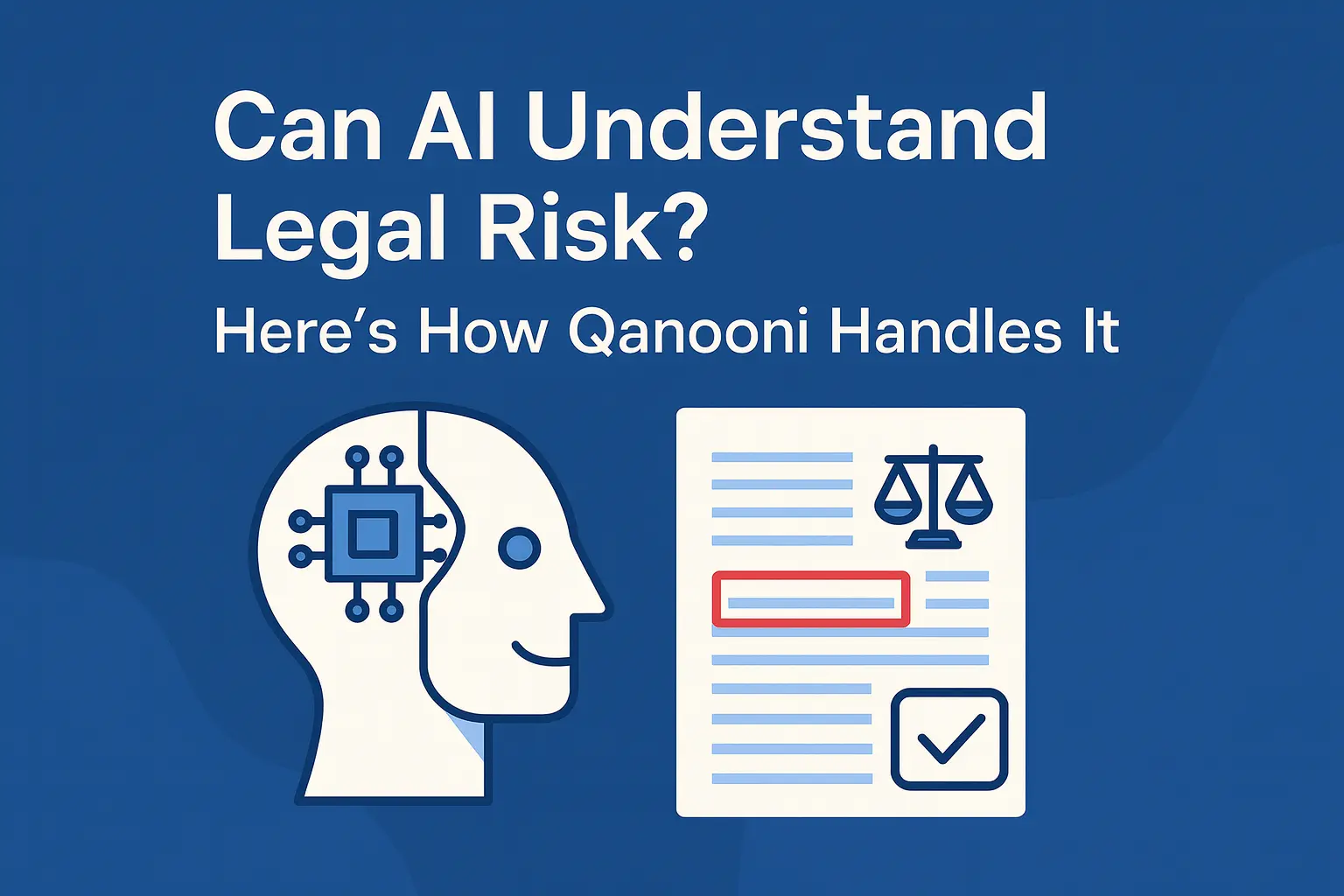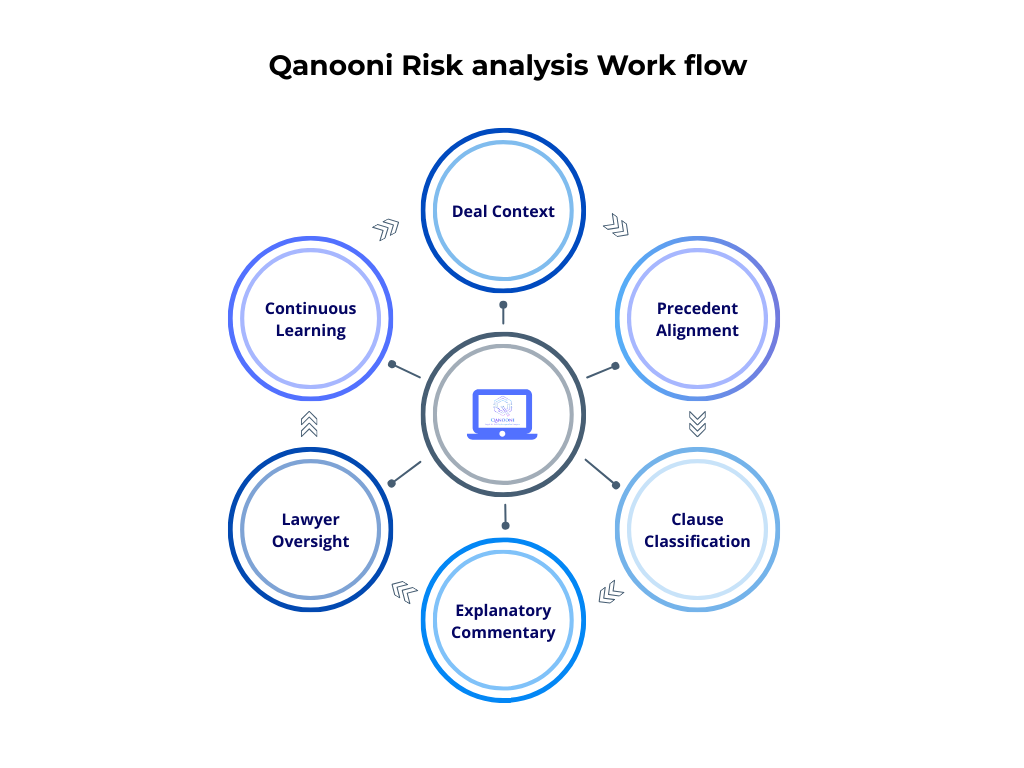
Can AI Understand Legal Risk? Here's How Qanooni Handles It
Lawyers have always approached contracts with a trained eye for risk. The challenge with artificial intelligence is that it often stops at the surface. It highlights words that look unusual, but it does not explain whether those words truly matter in the context of the deal, the client, or the governing law. This is why many lawyers remain sceptical: can AI genuinely understand legal risk, or is it destined to be just a highlighter with no judgement? In this piece, we explore where generic AI falls short, how Qanooni approaches risk differently, and why context-aware analysis is essential for law firms working across borders.
Defining AI Legal Risk Analysis
AI legal risk analysis is the use of artificial intelligence to identify, explain, and prioritise contract clauses that may create liability, conflict, or compliance problems in the context of a specific deal, jurisdiction, and firm standard.
That last part—in context—is what separates useful analysis from noise. Without it, AI is just a highlighter with no judgement.
Where Generic AI Fails
Lawyers who have trialled consumer AI tools often describe the same experience: the system confidently flags terms that are perfectly normal while sailing past clauses that a junior associate would never miss. A five-year contract term is labelled as a risk even though it is standard in a property lease. Meanwhile, a liability cap that omits carve-outs for fraud and IP infringement is passed over without comment. These are not trivial errors—they undermine trust and create more work, not less.
The root problem is that generic AI has no memory of your firm's standards, no awareness of governing law, and no sense of market practice. It sees difference but cannot tell danger from harmless variation. For lawyers, that distinction is everything.
Qanooni's Approach to Risk
At Qanooni, we set out to close this gap. Our system does not simply flag anomalies; it evaluates them the way a lawyer would. When reviewing a clause, Qanooni asks: what type of deal is this, who is the client, what law governs, and what has this firm historically accepted in similar matters? Only after weighing those factors does it assign a label. Clauses are marked as acceptable, non-standard, unacceptable, or missing—but critically, each label comes with commentary explaining why it matters. If your firm usually accepts a two-year SaaS term, Qanooni tells you that five years is an outlier and explains the lock-in risk it creates. That kind of reasoning turns a red highlight into genuine risk analysis.
The system also learns over time. Lawyer edits feed into Passive Playbooks, so Qanooni evolves with each firm's preferences rather than imposing a rigid external standard. This ensures that the tool reflects the way your lawyers practise, not the way outsiders think you should.
Examples in Practice
Consider a UAE employment contract. Many firms expect non-compete clauses to protect client interests. If that clause is missing, Qanooni does not stop at a blank label; it explains that under UAE practice, its absence creates enforceability gaps. Or take a limitation of liability clause in a UK contract. The UCTA reasonableness test requires such clauses to be fair and reasonable. Qanooni factors that into its analysis, flagging caps that fall outside your firm's normal band and linking the reasoning back to statutory controls. In the US, SaaS contracts routinely waive consequential damages, but the real fight is over carve-outs. Fraud, wilful misconduct, and IP claims are typically excluded. Qanooni highlights when these carve-outs are missing and explains how that deviates from market practice, citing ABA guidance.
Looking at the Middle East more broadly, ADGM and DIFC courts follow common law principles but apply them in a bilingual environment. An arbitration clause that works in London might be unenforceable if it omits Arabic translation provisions in Abu Dhabi or Dubai. Qanooni's bilingual awareness ensures those gaps are caught before they become disputes.
The Global Dimension
Risk profiles change as soon as you cross a border. In Dubai, a contract written only in English may be unenforceable without a certified Arabic translation. In London, that same contract would be entirely routine. In the US, state law can dramatically alter liability allocation in SaaS agreements. In the EU, GDPR and SCC rules reshape data clauses in cross-border deals. The SRA in the UK has also started issuing guidance on AI adoption, making governance and explainability non-negotiable. Any AI that does not account for these differences will mislead more often than it helps. Qanooni's architecture adapts analysis to each jurisdiction, ensuring the guidance reflects the realities of the forum in which the contract will be tested.
Why Contextual Risk Analysis Matters
The practical benefits of this approach are clear. Partners no longer waste time revisiting anomalies that are harmless. Associates work faster because the AI explains why something is flagged, not just what is unusual. Across offices, firms achieve consistency: everyone applies the same standard of risk, informed by the same precedent. For clients, the result is faster turnaround and clearer advice. For firms, it means more matters handled with less time wasted.
A pilot study with a UK commercial firm in 2024 showed that contextual risk analysis reduced review cycles by one full round and cut turnaround time by two days. For UAE firms, bilingual risk flagging prevented enforceability issues in employment disputes. These are tangible gains that generic AI could never deliver.
Visual Framework: Qanooni's Risk Logic

The Qanooni risk analysis process: from contextual analysis through precedent matching, risk scoring, explanatory commentary, and final lawyer review.
How Qanooni Compares
| Feature | Generic AI | Qanooni |
|---|---|---|
| Flags anomalies | ✅ | ✅ |
| Explains why it matters | ❌ | ✅ |
| Learns from firm precedents | ❌ | ✅ |
| Adapts by jurisdiction | ❌ | ✅ |
| Improves with edits | ❌ | ✅ |
FAQs
What is AI legal risk analysis?
AI legal risk analysis is the use of artificial intelligence to identify, explain, and prioritise clauses that may create legal or compliance risks in a contract. The key is context: deal type, jurisdiction, and firm precedent. Unlike generic anomaly detection, contextual AI provides reasoning lawyers can rely on.
Can AI replace lawyers in risk review?
No. AI can surface issues and provide commentary, but only lawyers can decide whether to accept risk. Regulatory bodies like the SRA and ABA emphasise that AI must remain under human oversight. Qanooni reflects this principle by requiring human-in-the-loop validation.
How does Qanooni classify clauses?
Qanooni labels clauses as acceptable, non-standard, unacceptable, or missing, with explanations tied to firm precedent and jurisdictional standards. This mirrors the way partners expect associates to present issues during review.
Does it adapt across jurisdictions?
Yes. Qanooni reflects UAE bilingual requirements, UK UCTA standards, US SaaS carve-outs, GDPR/SCC obligations in the EU, and even ADGM/DIFC arbitration practices. Its analysis shifts with forum and practice area.
What benefits do firms see from AI risk analysis?
Firms report faster reviews, fewer false positives, greater consistency across offices, and improved client satisfaction. In recent pilots, Qanooni users saved 8–10 hours weekly, handled over twice as many matters, and avoided enforceability pitfalls in bilingual contracts.
Closing Thought
AI can draw a red box around unusual words, but without context those boxes mean little. Legal risk is never universal; it shifts with the deal, the client, and the jurisdiction. That is why Qanooni was built differently. It learns from your precedents, adapts to your forums, and explains risk the way lawyers expect to see it explained. The lawyer remains in control; the AI accelerates the work. That is how legal AI becomes an asset, not another risk to manage.
See how Qanooni flags risk in your contracts → Book a Demo